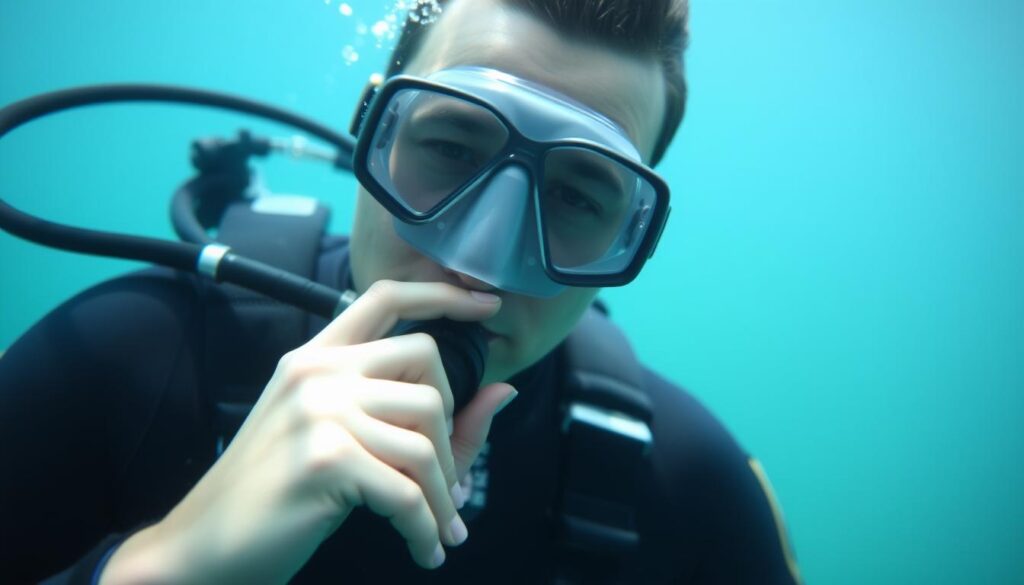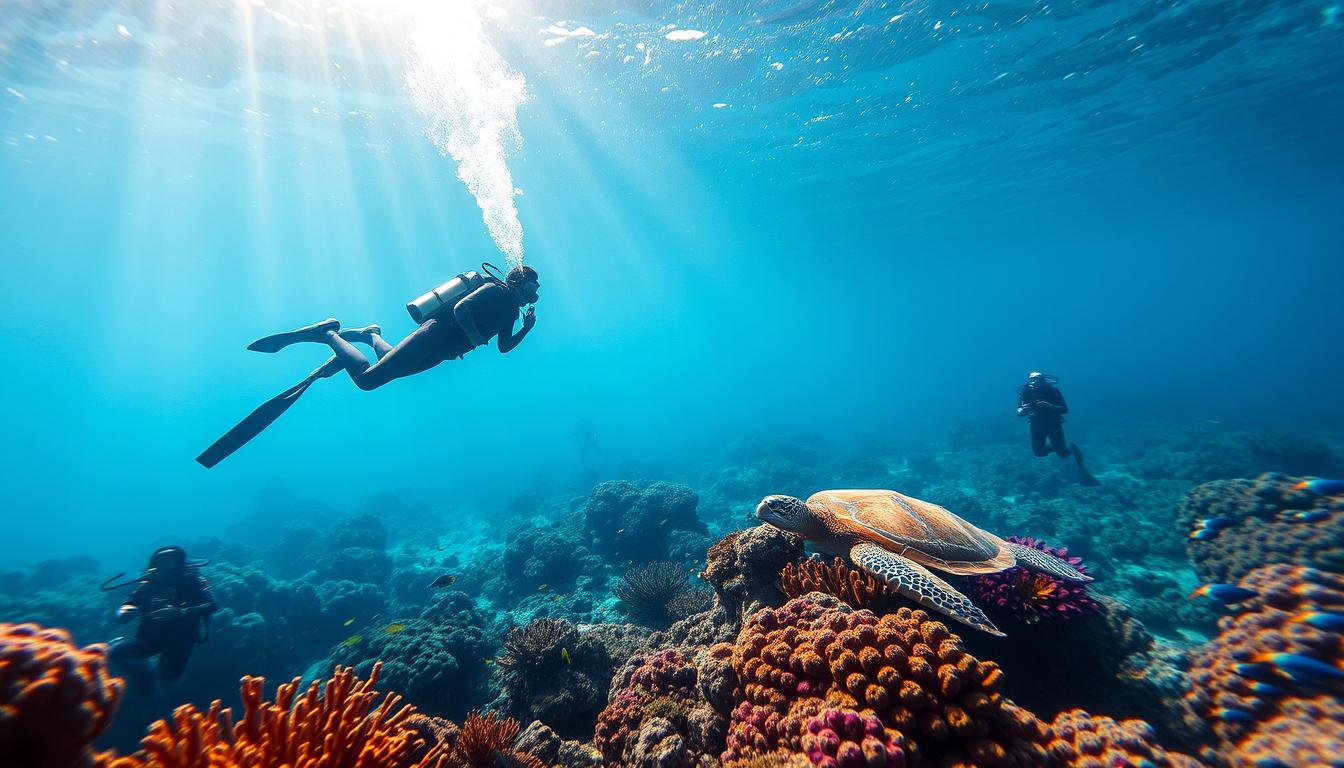Diving is exciting because you get to see underwater worlds. But, it can be risky without safety steps. Being safe makes diving better and helps protect sea life. This guide will teach divers important safety tips. It will make sure they have fun and keep the ocean safe.
Key Takeaways
- Get certified to dive safely.
- Always dive with a buddy.
- Plan your dive thoroughly: consider depth, duration, sea conditions, and entry/exit points.
- Conduct pre-dive equipment checks to ensure proper functionality.
- Monitor your air supply and practice proper equalization techniques.
- Ascend slowly and make safety stops.
- Maintain excellent buoyancy control to protect yourself and the marine environment.
Get Certified to Dive Safely
Getting a diving certification is key for safety and fun under the sea. Programs from PADI and NAUI teach divers important skills. These include using dive gear right, understanding diving science, and knowing what to do in emergencies.
Anyone who wants to dive should take a certification course. The training focuses on handling equipment safely. This is important to keep you and others safe underwater.
These courses also teach about protecting ocean life and diving responsibly. It’s important for divers to know how to act in surprises. This training gives divers the tools they need.
With a certification, divers feel more sure of themselves and know how to explore underwater. Learning step by step makes them ready for dive trips. It makes diving more enjoyable.
In short, getting certified is more than just a requirement. It makes you a skilled and safe diver. It helps protect everyone in the water.
Always Dive with a Buddy
Diving safety is key when exploring underwater. The best way to stay safe is to dive with a buddy. This means you always have help nearby if things go wrong. It’s a smart move because keeping an eye on each other reduces risks.
“I have witnessed first-hand how a buddy system can prevent mishaps,” says renowned diver and instructor Bruce Wienke, emphasizing the importance of having a dive partner.
Having a buddy is vital. If your gear breaks or you feel unwell, help is right there. This teamwork stops accidents. Your buddy also helps you with finding your way, handling gear, and talking underwater. It’s an extra safety net.
Let’s compare solo and buddy diving:
| Aspect | Diving Solo | Buddy Diving System |
|---|---|---|
| Emergency Response | Delayed, no immediate help | Immediate assistance available |
| Equipment Checks | Self-reliant | Mutual verification |
| Navigation | Self-navigated | Shared responsibility |
| Safety Monitoring | Solo monitoring | Mutual supervision |
Diving with a buddy is a key rule to avoid accidents. It makes you safer and helps protect all divers.
Plan Your Dive Thoroughly
Making a detailed dive plan is key for a safe dive. Following safety rules makes the trip better. Knowing about the depth, how long you’ll be down, the sea state, and where to get in and out is important.
Consider Depth and Duration
It’s important to know how deep and how long you’ll dive. Depth changes how much air you use and how your body takes in nitrogen. Choosing dives that you can handle is key.
Use your dive computer to keep track of these and stay safe from decompression sickness.
Assess Sea Conditions
Always check the sea’s condition before diving. The temperature, how clear the water is, and the currents can make diving riskier. Look at weather reports and talk to dive shops for updates.
Following scuba diving safety tips helps pick the best time and conditions for diving.
Identify Entry and Exit Points
Knowing where to get in and out of the water is crucial for dive safety guidelines. Make sure these spots are easy to get to and clearly marked. Learn about emergency exits too. Have another plan ready for surprises.
Planning these points makes your dive go smoothly and keeps you safe.
| Key Aspect | Why It’s Important |
|---|---|
| Depth and Duration | Affects air consumption and nitrogen absorption; crucial for avoiding decompression sickness. |
| Sea Conditions | Influences safety with factors like visibility, water temperature, and currents. |
| Entry and Exit Points | Ensures accessible, well-marked points for smooth entry and exit from the dive site. |
Conduct Pre-Dive Equipment Checks
Before any dive, ensuring your equipment’s safety is key. Always go through pre-dive safety checks. They help stop problems and make diving more fun and efficient.
Inspect Your Gear
Start by checking all your dive gear for wear or damage. This includes your regulator, BCD, and wetsuit. Everything must be in good shape.
Look for any cracks, scrapes, or signs that could make the gear unsafe. This step is crucial to ensure your safety while underwater.
Ensure Proper Functionality
Then, make sure every part works as it should. Fill your BCD to see if it leaks and check that your regulator gives good air flow. Straps and buckles must also be strong for underwater use.
Doing these checks can save your life.
Check Your Dive Computer
It’s important to check your dive computer too. Make sure its battery is full and it’s working right. Set it according to your dive plan.
Ensure the screen is clear and free of defects. This helps keep track of your depth and time safely.
To sum up, taking care of your dive gear and checking everything carefully is critical. Doing these steps reduces risks and makes for a great dive.
Diving Safety: Monitor Your Air Supply
It’s super important to monitor your air supply when diving. Make sure to check how much air you have often. This helps you have enough air for getting back to the surface safely and handling emergencies.
Not keeping an eye on your air can be very risky. It’s a big part of staying safe while diving. Learn how fast you use up air. This helps you plan your dives better. Things like how deep you go, how hard you work, and stress affect how much air you use.
Get in the habit of checking your air often while diving. This habit keeps you safe. Diving is fun, but being safe is key.
Plan your dive with your air in mind. Figure out how much air you’ll use and always have extra. Dive with friends who also check their air. This makes your dive safer.
Writing down your air use in a dive log is smart. It helps you get ready for next time. It helps you avoid problems before they happen.
Always keeping an eye on your air means you’ll have great and safe dives.
Practice Proper Equalization Techniques
Divers need to know how to adjust to underwater pressure. Not doing this can cause pain or harm.
Alleviate Ear Pressure
To help with ear pressure, divers can swallow or blow with their nostrils closed. This move is called the Valsalva maneuver. It opens the Eustachian tubes, balancing pressure between the ear and outside.
The Toynbee maneuver is another way to help. You swallow while pinching your nose. Both methods should be practiced often for easy use during a dive.

Prevent Ear and Sinus Injuries
Keeping ear and sinus injuries away is key for safe diving. Divers need to notice when they have trouble equalizing. If it’s hard to equalize, they should go up a bit and try again. If problems keep happening, it’s best to stop the dive to avoid injury.
It’s also important to follow emergency rules for divers. Knowing how to deal with ear injuries quickly is crucial. This way, divers can avoid big problems caused by pressure changes underwater.
Ascend Slowly and Make Safety Stops
When diving, one important rule is to ascend slowly to keep safe. Going up slowly helps avoid decompression sickness. It’s about letting your body get rid of extra nitrogen picked up underwater.
If you dive deeper than 32 feet, always do a safety stop. You stay at 15-20 feet deep for 3 to 5 minutes. This helps your body adjust and reduces the danger of nitrogen bubbles in your body. Following these steps helps prevent decompression sickness.
The best speed to go up after your safety stop is 30 feet every minute. This pace keeps your lungs safe and helps avoid decompression sickness. The last 15 feet of coming up are very important because the pressure changes a lot there.
| Dive Depth | Safety Stop Depth | Stop Duration |
|---|---|---|
| Below 10 meters | 5-6 meters | 3-5 minutes |
| 30 meters | 5 meters | 5 minutes |
Using diving stops right makes your dive safe. It lets your body handle the pressure changes well. By doing this, your dives become safer and more fun.
Maintain Excellent Buoyancy Control
Every scuba diver needs to master buoyancy control. It lets you move smoothly and safely under water. You also won’t bother the sea creatures. Learning perfect buoyancy means knowing how to handle your gear and move your body.
Master Finning Techniques
Good finning is crucial for buoyancy. Use small kicks to glide smoothly and save energy. Try different kicks like the frog or flutter to be more agile. Finning the right way keeps you safe and protects sea life.
Utilize Your Equipment Properly
Your gear, especially the Buoyancy Control Device (BCD), is key for buoyancy. Make sure your BCD fits right. Also, learn how to adjust its air. This helps you float just right. Remember, practice a lot and get advice from to get better.
Conclusion
Following diving safety tips is very important. It keeps you safe and helps protect the ocean. This summary talked about getting certified and diving with a friend. Planning your dive well is also key.
Checking your gear before diving and keeping an eye on your air is crucial. Also, know how to balance in water and how to clear your ears. Slowly going up and taking safety stops helps avoid getting sick from coming up too fast.
Learning more and training often make you a better diver. Always dive safely and know your limits. By sticking to these rules, divers can explore the sea safely and respect nature.
